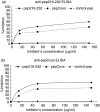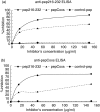Cross-reaction between antibodies to the major epitope of Ro60 kD autoantigen and a homologous peptide of Coxsackie virus 2B protein
- PMID: 15958081
- PMCID: PMC1809402
- DOI: 10.1111/j.1365-2249.2005.02812.x
Cross-reaction between antibodies to the major epitope of Ro60 kD autoantigen and a homologous peptide of Coxsackie virus 2B protein
Abstract
Coxsackie virus RNA has recently been detected in biopsy specimens of minor salivary glands from patients with primary Sjögren's Syndrome (pSS). A peptide derived from Coxsackie virus 2B protein (pepCoxs) presents 87% sequence homology with the 222-229 region of the major linear B-cell epitope of Ro60 kD autoantigen (pep216-232). Synthetic peptides corresponding to pep216-232: (216)KALSVETEKLLKYLEAV(232) and pepCoxs: (31)MVTSTITEKL LKNLVKI(47), were prepared. Sera from 42 patients with pSS and 43 patients with systemic lupus erythematosus (SLE) as well as sera from 27 healthy individuals (normal controls) and sera from 30 patients with rheumatoid arthritis (disease controls) were tested against the two homologous peptides. Twenty-five percent of SLE sera and 33.3% of pSS sera reacted against pep216-232, whereas 28% of SLE sera and 37% of pSS sera recognized the pepCoxs. The sera reacting with pep216-232 were apparently the same as those reacting with pepCoxs. Normal sera and disease control sera presented only a limited reactivity against both peptides (ranging from 3.7% to 10%). Both peptides reacted more prominently with anti-Ro/La (+) sera from pSS patients. Thus, pep216-232 was recognized by 17% of the anti-Ro (+) sera and by 42% of the anti-Ro/La (+) sera, whereas pepCoxs was recognized by 28.5% and 38% of the a-Ro(+) and a-Ro/La(+) sera, respectively. Purified anti-pep216-232 antibodies readily reacted with both peptides while inhibition experiments revealed the specificity of this reaction. These results suggest a possible cross-reaction between antibodies to the major linear B-cell epitope of Ro60 kD autoantigen and the homologous pepCoxs in pSS patients. This cross-reaction might potentially play a role in autoantibody formation and the perpetuation of the autoimmune response against Ro/SSA and La/SSB.
Figures





Comment in
-
Viruses contribute to the development of Sjögren's syndrome.Clin Exp Immunol. 2005 Jul;141(1):19-20. doi: 10.1111/j.1365-2249.2005.02827.x. Clin Exp Immunol. 2005. PMID: 15958065 Free PMC article. No abstract available.
Similar articles
-
Calreticulin binds preferentially with B cell linear epitopes of Ro60 kD autoantigen, enhancing recognition by anti-Ro60 kD autoantibodies.Clin Exp Immunol. 2003 Oct;134(1):143-50. doi: 10.1046/j.1365-2249.2003.02246.x. Clin Exp Immunol. 2003. PMID: 12974767 Free PMC article.
-
Post-translational modifications of the major linear epitope 169-190aa of Ro60 kDa autoantigen alter the autoantibody binding.Clin Exp Immunol. 2006 Oct;146(1):60-5. doi: 10.1111/j.1365-2249.2006.03192.x. Clin Exp Immunol. 2006. PMID: 16968399 Free PMC article.
-
Preferential recognition of the phosphorylated major linear B-cell epitope of La/SSB 349-368 aa by anti-La/SSB autoantibodies from patients with systemic autoimmune diseases.Clin Exp Immunol. 2006 Jun;144(3):432-9. doi: 10.1111/j.1365-2249.2006.03088.x. Clin Exp Immunol. 2006. PMID: 16734612 Free PMC article.
-
Fine specificity of the autoimmune response to the Ro/SSA and La/SSB ribonucleoproteins.Arthritis Rheum. 1999 Feb;42(2):199-209. doi: 10.1002/1529-0131(199902)42:2<199::AID-ANR1>3.0.CO;2-1. Arthritis Rheum. 1999. PMID: 10025913 Review.
-
Target antigens of the SSA/Ro and SSB/La system.Am J Reprod Immunol. 1992 Oct-Dec;28(3-4):256-8. doi: 10.1111/j.1600-0897.1992.tb00809.x. Am J Reprod Immunol. 1992. PMID: 1285896 Review.
Cited by
-
T-Cell Receptor Sequences Identify Combined Coxsackievirus-Streptococci Infections as Triggers for Autoimmune Myocarditis and Coxsackievirus-Clostridia Infections for Type 1 Diabetes.Int J Mol Sci. 2024 Feb 1;25(3):1797. doi: 10.3390/ijms25031797. Int J Mol Sci. 2024. PMID: 38339075 Free PMC article.
-
Laser Reduced Graphene Oxide Electrode for Pathogenic Escherichia coli Detection.ACS Appl Mater Interfaces. 2023 Feb 22;15(7):9024-9033. doi: 10.1021/acsami.2c20859. Epub 2023 Feb 14. ACS Appl Mater Interfaces. 2023. PMID: 36786303 Free PMC article.
-
The microbiome in autoimmune diseases.Clin Exp Immunol. 2019 Jan;195(1):74-85. doi: 10.1111/cei.13158. Clin Exp Immunol. 2019. PMID: 29920643 Free PMC article. Review.
-
Current State of Knowledge on Primary Sjögren's Syndrome, an Autoimmune Exocrinopathy.J Clin Med. 2020 Jul 20;9(7):2299. doi: 10.3390/jcm9072299. J Clin Med. 2020. PMID: 32698400 Free PMC article. Review.
-
T cell epitope mimicry between Sjögren's syndrome Antigen A (SSA)/Ro60 and oral, gut, skin and vaginal bacteria.Clin Immunol. 2014 May-Jun;152(1-2):1-9. doi: 10.1016/j.clim.2014.02.004. Epub 2014 Feb 19. Clin Immunol. 2014. PMID: 24576620 Free PMC article.
References
-
- James JA, Harley JB, Scofield RH. Role of viruses in systemic lupus erythematosus and Sjogren syndrome. Curr Opin Rheumatol. 2001;13:370–6. - PubMed
-
- Triantafyllopoulou A, Tapinos N, Moutsopoulos HM. Evidence for coxsackievirus infection in primary Sjogren's syndrome. Arthritis Rheum. 2004;50:2897–902. - PubMed
-
- Agirre A, Barco A, Carrasco L, Nieva JL. Viroporin-mediated membrane permeabilization. Pore formation by nonstructural poliovirus 2B protein. J Biol Chem. 2002;277:40434–41. - PubMed
MeSH terms
Substances
LinkOut - more resources
Full Text Sources
Medical
Research Materials

